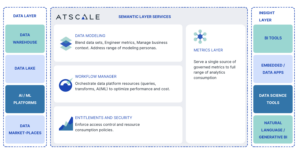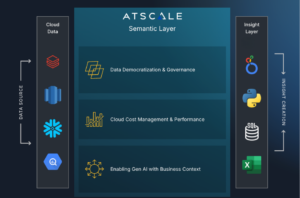In today’s data-driven world, organizations are inundated with vast amounts of data generated from countless sources. The challenge lies in managing this data deluge and ensuring its reliability, relevance, and integrity. A promising solution to this challenge is implementing a semantic layer in data governance. This approach offers a transformative method to manage data, ensuring that it is accurate, consistent, and meaningful across all users within an organization.
Understanding the Semantic Layer
A semantic layer acts as an intermediary between raw data and the end-users who interact with it. It abstracts the complexities of the underlying data infrastructure, providing a user-friendly interface that translates technical data into business-friendly terms. This layer enables users to access and analyze data without needing deep technical knowledge, promoting better decision-making and governance.

Ensuring Reliability Through Semantic Layers
Reliability in data governance means that the data is accurate and trustworthy. A semantic layer contributes to this in several ways:
- Data Standardization: Semantic layers enforce consistent definitions and calculations across the organization. For example, the definition of “customer lifetime value” will be the same whether accessed by the marketing department or the finance team. This standardization ensures that all users are working with the same data definitions, reducing discrepancies and errors.
- Data Validation: Semantic layers can incorporate rules and checks that validate data as it is ingested and processed. This ensures that only high-quality, accurate data is made available to users. By catching and correcting errors early, semantic layers maintain the reliability of the data.
- Real-Time Updates: In fast-paced business environments, data needs to be current to be reliable. Semantic layers can integrate with real-time data sources, ensuring that users always have access to the most up-to-date information. This capability is crucial for making timely and informed decisions.
Relevance in Data Governance
Relevance ensures that the data accessed and used is pertinent to the users’ needs. Semantic layers enhance relevance by:
- Contextualization: Semantic layers provide context to raw data, making it more meaningful and actionable. For example, a semantic layer can translate raw sales data into customer preferences and buying trend insights. Users can derive more meaningful insights by presenting data in a business-relevant context.
- Personalization: Different users have different data needs. A semantic layer can tailor data views and reports to individual roles within the organization. This means a sales manager will see data relevant to sales performance, while a product manager will see data pertinent to product development. Personalized data views ensure users get the necessary information without sifting through irrelevant data.
- Aggregation and Drill-Down Capabilities: Semantic layers can aggregate data from multiple sources, providing a comprehensive business view. Users can start with high-level summaries and drill down into more detailed data as needed. This flexibility ensures that users can access data at the level of detail most relevant to their needs.
Maintaining Integrity with Semantic Layers
Integrity in data governance refers to the accuracy and consistency of data over its lifecycle. Semantic layers play a crucial role in maintaining data integrity by:
- Consistency Across Users: By providing a single source of truth, the semantic layer ensures that all users access consistent information. This uniformity prevents conflicting interpretations and promotes a shared understanding among stakeholders.
- Access Control and Security: The semantic layer enforces robust access control mechanisms, ensuring that only authorized users can access sensitive information. This security is crucial for maintaining the confidentiality and integrity of data, particularly in governance contexts where data sensitivity is high.
- Data Governance Policies: The semantic layer supports the implementation of comprehensive data governance policies, including data stewardship, compliance, and privacy regulations. By embedding these policies into the data management process, the semantic layer ensures that data is handled ethically and legally.
Implementing Semantic Layers: Best Practices
Implementing a semantic layer requires careful planning and execution. Here are some best practices to consider:
- Stakeholder Involvement: Engage stakeholders from various departments to understand their data needs and challenges. This ensures that the semantic layer is designed to meet the diverse needs of the entire organization.
- Data Governance Framework: Establish a robust data governance framework that includes policies, procedures, and standards for data management. The semantic layer should align with this framework to ensure consistency and compliance.
- Continuous Improvement: Data needs and technologies evolve over time. Regularly review and update the semantic layer to ensure it continues to meet the organization’s needs. Encourage feedback from users to identify areas for improvement.
- Training and Support: Provide training and support to users to ensure they understand how to use the semantic layer effectively. This includes educating them on data definitions, reports, and analysis tools.
Real-World Applications
The benefits of the AtScale semantic layer are evident in various real-world governance applications across industries like financial services, manufacturing and retail.
Financial Industry
In the financial sector, the semantic layer plays a crucial role by standardizing and harmonizing data from different financial institutions. This standardization enhances the transparency and accountability of financial transactions, helping to prevent fraud. For instance, a global financial services company leverages the AtScale semantic layer to create a common metrics layer for data analysis across the firm. They have developed a pipeline that integrates AutoML capabilities into workflows for Excel and Power BI-based analysts and migrated their entire analytics infrastructure to Snowflake and Amazon SageMaker on AWS. This approach provides significant business value by enabling business units to make critical decisions based on data and advanced analytics. Furthermore, product placement, cross-sell, up-sell, and customer engagement are now scored and measured for performance, leading to better business outcomes.
Manufacturing Industry
The manufacturing industry gathers vast amounts of data from various sources, including machinery sensors, production lines, supply chains, and customer interactions. A semantic layer integrates and standardizes this data, providing a unified view that ensures consistency and accuracy across the organization. For example, a global manufacturing company utilizes the AtScale semantic layer to:
- Standardize and streamline the user experience for working with data across the enterprise.
- Reduce duplicative modeling work
- Accelerate enterprise data literacy and solve problems with data
- Deliver self-service analytics for large user populations
- Reduce cloud costs and provide a predictable cost model for analytics
Retail Industry
In the retail industry, companies utilize semantic layers to integrate and standardize data from various sources, such as inventory systems, sales transactions, and customer interactions, ensuring consistency and accuracy across the organization. For example, national retailer utilized the AtScale semantic layer to:
- Developed a new line of business with a real-time supply chain optimization app
- Increased depth of analysis possible from a single store and category to every store at SKU granularity for 3+ years of history
- Reduced cloud spending by 80% while improving query performance by an order of magnitude
Conclusion
In the era of big data, ensuring data reliability, relevance, and integrity is paramount for effective governance. Semantic layers offer a powerful solution to these challenges, bridging complex data systems and business users. By standardizing data definitions, validating accuracy, contextualizing information, and maintaining consistent data models, semantic layers empower organizations to make informed, data-driven decisions. As organizations continue to embrace digital transformation, adopting semantic layers will be a key factor in achieving robust and effective data governance.

SHARE
ANALYST REPORT